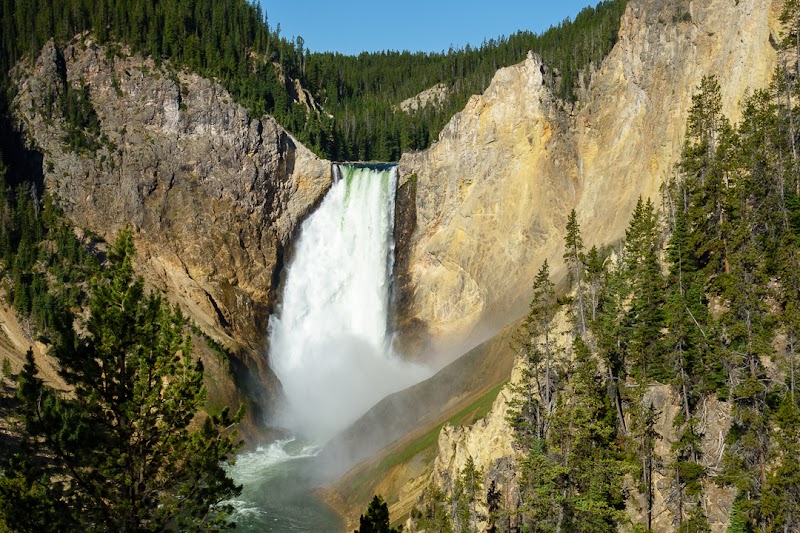
Experience Yellowstone’s wild side with Mammoth’s Summer Ranger Programs—structured hikes and interactive talks that bring the park’s ecology and history to life. Designed for all skill levels, these programs offer practical tips and immersive nature encounters that prepare you for exploration with respect and awareness.
Hydrate Regularly
Wyoming’s high elevation and dry air can quickly deplete your hydration, so carry at least 2 liters of water when joining any ranger-led hike.
Wear Appropriate Footwear
Trails range from rocky to thermal-soil surfaces; sturdy hiking boots with good ankle support will prevent injuries and improve grip on uneven ground.
Start Early for Wildlife
Morning hours are best for spotting animals and avoiding afternoon heat; plan your ranger program participation accordingly for optimal experience.
Layer Clothing for Weather Shifts
Mountain weather can change rapidly. Carry light rain gear and thermal layers, even in summer, to stay comfortable and prepared during sudden shifts.
Navigating Summer Ranger Programs in Mammoth, Wyoming: Adventure Meets Discovery
Mammoth, Wyoming, serves as the gateway to Yellowstone's northern range, where the summer ranger programs offer a practical yet thrilling way to engage with one of America's most dynamic landscapes. These programs provide structured hikes, wildlife talks, and interactive learning experiences tailored for all visitor levels—from families taking their first steps into the wild, to seasoned hikers seeking deeper understanding of the park’s ecosystem.
Starting your morning with a ranger-led hike means setting foot on trails where every bend tells a story. Trails vary from easy walks around the Mammoth Hot Springs terraces to more moderate treks like the Soda Butte Creek trail, which spans about 3.5 miles round trip with an elevation gain of roughly 400 feet. These forested routes invite you to watch thermal features steaming in cool mountain air, while rivers dare you quietly with their persistent currents.
The programs emphasize not just sightseeing but interaction—spotting bison with a ranger’s binoculars or learning how to respect a bear’s domain. Rangers encourage asking questions, sharing practical tips on hydration—critical under the Wyoming sun—and recommending footwear suited to rocky, sometimes uneven terrain. Sessions run throughout the day, allowing visitors to plan hikes around cooler morning or late afternoon windows when wildlife is most active.
Ranger talks often occur near the historic Albright Visitor Center, where the past whispers through exhibits about Mammoth's early settlers and the park's geothermal features. Participants learn about the delicate balance of preserving Yellowstone’s fiercely independent wilderness by minimizing human impact.
For those prepared to explore solo, the programs provide maps and safety briefings that encourage confidence in reading terrain and weather shifts—because Wyoming mountain weather can change sharply, a reminder of nature’s restless character. Campsites near Mammoth offer practical staging points, equipped with water sources and regulations to keep the wild protected.
Joining a ranger program transforms a hike from simple exercise into an informed adventure. The natural world here is a storyteller with its own temperament—its rivers push, its geysers pulse unpredictably, and its forests whisper warnings. Respect and preparation turn this engagement into memorable discovery, whether you’re tracing elk trails or marveling at sunset hues over steaming mineral springs.
In sum, Mammoth’s summer ranger programs blend adventure with education and practical advice. They invite visitors to step into Yellowstone with eyes wide open and feet ready to roam smartly, making every hike a meaningful encounter with a landscape that demands both enthusiasm and respect.
Nearby Trips
All Adventures
Boat Charters
Water Activities
Adventures near Mammoth, Wyoming
Discover the unique and memorable adventures that make Mammoth, Wyoming special.
Frequently Asked Questions
Are Mammoth’s ranger programs suitable for children?
Yes. Many programs are family-friendly and designed to engage children with interactive activities and safe trail routes, particularly around Mammoth Hot Springs.
What is the best way to prepare for sudden weather changes during the hikes?
Bring layered clothing, a waterproof jacket, and keep an eye on daily forecasts or any updates given by park rangers before and during hikes.
Can I join ranger hikes without prior registration?
Most summer programs are first-come, first-served, but during peak season it’s best to arrive early or check the park’s schedule online to secure a spot.
What wildlife is commonly seen during these programs?
Visitors often spot bison, elk, marmots, and sometimes wolves or bears at a safe distance under ranger guidance.
Are pets allowed on ranger-led hikes?
Pets are prohibited on trails within Yellowstone National Park to protect wildlife and the environment.
How physically demanding are the ranger program hikes?
Most are moderate with some elevation gain, suitable for visitors with average fitness but requiring comfortable walking ability on uneven terrain.
Recommended Gear
Hiking Boots
Protect feet on varied terrain, from rocky paths to thermal ground patches.
Water Bottle or Hydration System
Necessary to maintain hydration in dry, high-elevation air.
Layered Clothing
Allows quick adaptation to temperature shifts throughout the day.
Binoculars
Enhances wildlife viewing, especially on longer ranger hikes.
Local Insights
Hidden Gems
- "The Blacktail Plateau Drive offers quiet scenic views often missed on busier routes."
- "Swan Lake Flats are a lesser-known area for birdwatching during summer mornings."
Wildlife
- "Keep an eye out for elusive coyotes and the occasional herd of bighorn sheep grazing near Mammoth."
- "Magpies and mountain bluebirds add color and sound to the forest edges."
History
"Mammoth Hot Springs was home to the Fort Yellowstone army base, which played a role in early park management and preservation efforts."
